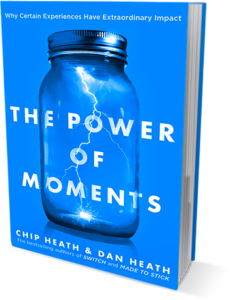Business Bloggers Can be Authors of Defining Moments

In The Power of Moments: Why Certain Experiences Have Extraordinary Impact, authors Chimp and Dan Heath posit that there are certain brief experiences which jolt us, change us, and elevate us. What if a teacher could design a lesson he knew students would remember twenty years later, they ask. What if a manager knew how to create an experience that would delight customers?
And what if (reading this book made me ponder), we knew how to create content that would delight readers and emblazon our clients’ brands in prospects’ and customers’ minds and hearts? Isn’t that, I asked myself, really what this business blog marketing thing is all about?
When people assess an experience, the Heath brothers explain, they tend to forget or ignore its length and rate it, in retrospect, based on the best or worst moment (“the peak”) and the ending. Translated into the construction of a marketing blog post, while it’s the keyword phrase that starts the job of getting the blog found, a big part of blog content writing, I’ve found, involves getting what I call the “pow opening line” right.
The opener might consist of an anomaly (a statement that, at first glance, doesn’t appear to fit). Or, the opener might be a bold assertion or “in-your-face” statement. The “pow” opener puts words in readers’ mouths – when talking to others about this topic, readers will tend to use the very words you will have, figuratively, “put in their mouths”. Seth Godin’s “There are actually two recessions” is a perfect example of impactful, thought-changing discussion-piece openers.
The Power of Moments authors talk about ”flipping pits into peaks”, turning customer complaints into positive, memorable experiences. You want to get things wrong, then have customers bring those mistakes to your attention, so that you can create a memorable “fix”. For us blog content writers, the lesson is this: writing about past business failures is important! True stories about mistakes and struggles are very humanizing, adding to the trust readers place in the people behind the business or professional practice.
Readers, I explain to business owners and practitioner clients, even the ones who have subscribed to your blog, are not going to peruse, much less study, every word in every one of your blog posts, however relevant the information, however artfully worded. What we’re shooting for as blog writers is to be authors of defining moments for readers rather than merely waiting for those moments to happen!





Follow us online!